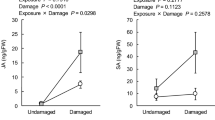Abstract
When infested by herbivorous mites, cotton seedlings produce volatile cues that elicit attraction of predatory mites. Experiments were carried out to elucidate how downwinduninfested conspecific seedlings are affected by these volatiles. It was found that the rate of oviposition of herbivorous mites was reduced on seedlings exposed to volatiles from infested seedlings. Moreover, predatory mites were attracted by exposeduninfested seedlings. These results strongly suggest that uninfested plants are better protected against herbivore attack when exposed to airborne chemicals released by their infested neighbours.
Similar content being viewed by others
References
Price, P. W., in: Interactions of Plant Resistance and Parasitoids and Predators of Insects, p. 11. Eds D. J. Boethel and R. D. Eikenbary. Ellis Horwood Ltd. Chichester 1986.
Price, P. W., Bouton, C. E., Gross, P., McPheron, B. A., Thompson, J. N., and Weis, A. E., A. Rev. Ecol. Syst.11 (1980) 41.
Dicke, M., Sabelis, M. W., Takabayashi, J., Bruin, J., and Posthumus, M. A., J. chem. Ecol.16 (1990) 3091.
Turlings, T. C. J., Tumlinson, J. H., and Lewis, W. J., Science250 (1990) 1251.
Sabelis, M. W., and van de Baan, H. E., Ent. exp. appl.33 (1983) 303.
Dicke, M., Infochemicals in Tritrophic Interactions: Origins and Function in a System Consisting of Predatory Mites, Phytophagous Mites and their Host Plants. Ph. D. Thesis Agricultural University, Wagening, The Netherlands 1988.
Dicke, M., and Sabelis, M. W., Neth. J. Zool.38 (1988) 148.
Dicke, M., and Sabelis, M. W., in: Causes and Consequences of Variation in Growth Rate and Productivity of Higher Plants, p. 341. Eds H. Lambers, H. Konings, M. L. Cambridge and T. L. Pons. SPB Academic Publishing bv, The Hague 1989.
Dicke, M., van Beek, T. A., Posthumus, M. A., Ben Dom, N., van Bokhoven, H., and de Groot, E., J. chem. Ecol.16 (1990) 381.
Karban, R., and Carey, J. R., Science225 (1984) 53.
Williams, H. J., Elzen, G. W., and Vinson, S. B., in: Novel Aspects of Insect-Plant Interactions, p. 171. Eds. P. Barbosa and D. K. Letourneau. John Wiley and Sons, New York 1988.
Zeringue, H. J., Phytochemistry26 (1987) 1357.
Baldwin, I. T., and Schultz, J. C., Science221 (1983) 277.
Rhoades, D. F., in: Plant Resistance to Insects, p. 37. Ed P. A. Hedin. ACS, Washington 1983.
Rhoades, D. F., Rec. Adv. Phytochemistry19 (1986) 195.
Fowler, S. V., and Lawton, J. H., Am. Nat.126 (1985) 181.
Takabayashi, J., Dicke, M., and Posthumus, M. A., Phytochemistry30 (1991) 1459.
Wall, C., Sturgeon, D. M., Greenway, A. R., and Perry, J. N., Ent. exp. appl.30 (1981) 111.
Wall, C., and Perry, J. N., Ent. exp. appl.33 (1983) 112.
Dabrowski, Z. T., and Rodriguez, J. G., J. Econ. Ent.64 (1971) 387.
Sabelis, M. W., and de Jong, M. C. M., Oikos53 (1988) 247.
Author information
Authors and Affiliations
Rights and permissions
About this article
Cite this article
Bruin, J., Dicke, M. & Sabelis, M.W. Plants are better protected against spider-mites after exposure to volatiles from infested conspecifics. Experientia 48, 525–529 (1992). https://doi.org/10.1007/BF01928181
Received:
Accepted:
Published:
Issue Date:
DOI: https://doi.org/10.1007/BF01928181




